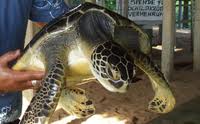 |
Home About Directory Conservation |
 |
Rumassala Marine Sanctuary Location: 60 2’ 45 N and 800 13’ 45 E to 60 0’ 0 N and 800 15’ 45 E; 666949 N and 415156 E to 663261 N and 416996 E; in the southern end of Galle Bay, in the Galle District, of the Southern Province. Area: 1,707 ha Altitude: Sea level to a depth of around 8m Overview: The Rumassala Marine Sanctuary encompasses a small near-shore coral reef growing on hard substrate around the base of the Rumassala hill in the sheltered waters of Galle Bay. Despite its small size, the reef is known for its rich biodiversity and is an important habitat for many marine species. It is important for small-scale fisheries, collection of ornamental fish and tourism. The reef has been degraded by the use of dynamite for fishing and coral bleaching. Physical features: The reef is sheltered from rough seas by a rocky headland, and unlike most fringing reefs along the southern coast, does not have a shallow reef crest and reef lagoon. Coral communities occur on old limestone and rock habitats along the seafloor. Coral patches varying in size from a few meters to over 30m across are located a few meters away from the shore, and extend around 200m towards the sea to a depth of around 8m. Some spur and groove formations are found in deeper areas. Shallower areas contain large stands of hard coral, while deeper areas contain rocky habitats with scattered colonies of hard and soft corals. Rumassala lies within the wet zone of Sri Lanka, which is characterized by an annual rainfall of over 2,000mm per year and average annual temperatures of around 27oC. The reef is influenced by the southwest monsoon from May to October, although wave energy is reduced due to its sheltered location. However, strong currents and freshwater input results in increased turbidity during this period. Sedimentation is relatively high due to poor water circulation as the reef is located within an enclosed bay. Ecological features: The reef was dominated by branching and tabulate Acropora spp. with significant stands of Montipora spp. and Porites rus. However, much of the Acropora was destroyed during mass coral bleaching in 1998, which resulted in the mortality of most corals. The reef has now been re-colonized mostly by Pocillopora damicornis and Porites rus, and live coral cover is around 25%. Over 500 species of reef and reefassociated fish have been recorded from the reef. Major fish groups include damselfishes (Pomacentridae), wrasses (Labridae) and surgeonfishes (Acanthuridae). Noteworthy fauna: The coral species Porites desilveri is restricted to Sri Lanka. Among the reef fish, Chlorurus rhakoura and Pomacentrus proteus are endemic to Sri Lanka, while Cheilinus undulates is globally endangered. The protected Labroides bicolor has been recorded at the site, while Carcharhinus melanopterus are occasionally seen on the reef. Four species of globally endangered marine turtles (Eretmochelys imbricata, Chelonia mydas, Lepidochelys olivacea and Dermochelys coriacea) visit the reef. Noteworthy flora: Information not available Land use: Fishing and ornamental fish collection is carried out by the local communities. There is some tourism due to its proximity to the tourist areas of Unawatuna and Galle. Possible changes in land use: Use of dynamite for fishing has caused extensive damage to the reef structure and has reduced fish stocks. Continued reef degradation may have impacts on fisheries related livelihoods. The use of dynamite can also decrease tourist appeal for the reef. Hydrological and biophysical values: The reef is part of a larger system of coral reefs around the Rumassala headland, which includes the coral reefs at Unawatuna. There is high recruitment of larvae of many species, probably due to its location and prevailing current patterns. Social and cultural values: The Galle Bay area has a maritime heritage as a natural harbour, and was a major sea port during the periods of Portuguese, Dutch and British occupation in Sri Lanka. Rumassala which is located close to the main harbour area is therefore an important marine archaeological site, and the watering point on Rumassala hill was important during the colonial period. The reef supports a number of artisanal fishermen using traditional methods such as hook and line fishing. The reef and secluded beach is popular among locals for recreation and is visited by tourists from nearby areas. Scientific research and monitoring: The reef is being studied by NARA with support from the GCRMN and CORDIO. The Nature Conservation Group has also carried out extensive surveys of the coral reef. Conservation education: The Nature Conservation Group has undertaken numerous community education activities to promote conservation of the reef and encourage sustainable use of resources. Recreation and tourism: The beach area near the reef is a popular picnic and recreation area for locals. Tourists from Galle and Unawatuna also visit the area for snorkelling on the reef and use of the beach. SCUBA diving operators based in Unawatuna also conduct diving tours to the reef. Conservation measures taken: The reef area was declared as a Marine Sanctuary in 2003 under the FFPO. However, there is no implementation of regulations. Conservation measures proposed: Information not available Disturbance and threats: Destructive fishing practices such as the use of dynamite and bottom set nets, and extensive collection of ornamental species is degrading the reef impacting on the biodiversity. Sedimentation can also lead to increased coral mortality and reduce recruitment. The 2004 Tsunami did not result in any significant mechanical damage to corals in Rumassala. Need urgent actions to mitigate existing threats. Land tenure: State owned Management authority and jurisdication: DWC References: Karunarathne and Weerakkody (1998); NARA/CORDIO/IUCN/GCRMN/SLSAC (2005); Rajasuriya et al. (1995); Rajasuriya et al. (2006) |
| Maps |